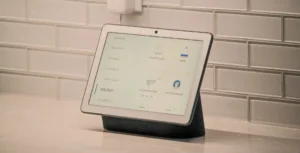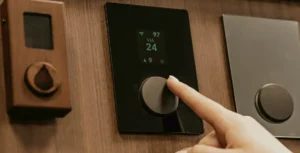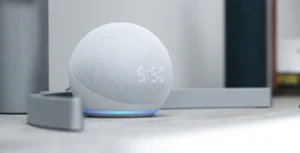A single smart power strip can turn a cluster of always-on devices into a controllable, schedulable, energy-saving setup — and that adds up to real dollars saved every month. In 2025, the category has matured: power strips now combine surge protection, individually controlled outlets, USB ports, energy monitoring, and support for modern smart home ecosystems (Alexa, Google, HomeKit/Matter). This guide explains what smart power strips do, whether they’re worth it, how to use them to save energy, and which models to consider — with five great picks for the U.S. (Amazon) market and five realistic options for European buyers (AliExpress).
For a more comprehensive approach to reducing household electricity, consider pairing a smart power strip with efficient appliances and a smart thermostat. See our guide: How to Save Energy with Smart Home Technology.
What is a smart power strip?
A smart power strip is an extension cord/surge protector that adds intelligence to standard power outlets. Typical capabilities include:
- Multiple individually-controlled AC outlets (so each device can be turned on/off separately).
- USB charging ports (sometimes USB-C) for direct device charging.
- App control (on/off, schedules, timers) via a vendor app (Kasa, Meross, Tuya/Smart Life, etc.).
- Voice assistant integration (Amazon Alexa, Google Assistant, and increasingly Matter/HomeKit).
- Surge protection and safety features (joule ratings, overload protection).
- Energy monitoring (reports watts and kWh for one or more outlets).
Because they cluster many outlets into a single, intelligent piece of hardware, smart power strips are often the most cost-effective way to convert many devices to “smart” control at once.
Is a smart power strip worth it?
Short answer: Yes — in many households. Here’s why:
- Eliminate phantom loads — Devices like TVs, game consoles, printers, and chargers draw standby power when “off.” Turning the outlet fully off via an app or schedule saves that wasted electricity.
- Automation & schedule-driven savings — Set non-essential devices to turn off at night or when nobody’s home. Even small reductions compound over months.
- Energy visibility — Strips with energy monitoring help you identify the real power hogs and take focused action.
- Safety & convenience — Surge protection + centralized control simplifies cable management and reduces risk.
But smart power strips aren’t magic. They’re most cost-effective when used to control several devices that otherwise run or draw standby power for long periods. Don’t plug your refrigerator or HVAC into a cheap strip — those require hard-wired or professionally installed solutions. For a broader energy plan, pair strips with smart thermostats and energy-efficient appliances.
How to use a smart power strip (practical step-by-step)
- Pick the right location — entertainment center, home office desk, kitchen counter (for small appliances), or bedside area.
- Choose what to control — ideal candidates: TV + soundbar + game console; PC + monitor + speakers; coffee machine + kettle (only if strip ratings match); chargers and lamps. Avoid large fixed appliances (fridge, oven).
- Group by usage — put devices you want to control separately on individual outlets; use always-on outlets for routers or critical devices.
- Set schedules — nightly off for entertainment gear; daytime on for slow-cookers; off during working hours for home chargers.
- Monitor energy — if your strip supports metering, watch the data for 1–2 weeks and identify the biggest consumers. Then automate or replace the worst offenders.
- Combine automations — trigger power strip scenes from motion sensors, away mode, or your smart thermostat to avoid unnecessary loads.
Start with 1–2 strips in the highest-impact areas, measure, and expand where the data shows wins.
Smart power strips on Amazon (U.S. market) — 5 recommended models
Below are five well-established smart power strips available on Amazon for U.S. buyers. These represent the mix of features consumers want in 2025: individual outlets, surge protection, app + voice integration, and (in some cases) energy monitoring.
Notes: all Amazon selections are chosen for availability, reputation, and feature set. Prices and stock change frequently — check the product page for the latest.
1. TP-Link Kasa HS300 Smart Power Strip
Overview:
TP-Link Kasa has six individually controlled smart outlets + 3 USB ports, built-in surge protection, Kasa app control, Alexa & Google integration. A long-time favorite for home offices and entertainment centers.
Pros:
- Reliable app.
- Good build quality.
- Each outlet is independent.
- Strong reputation.
Cons:
- Lacks detailed per-outlet energy metering on older firmware (some newer variants improved this).
- Slightly bulkier strip.
Best for: Users who want a dependable, multi-outlet strip from a trusted brand.
2. Meross Smart Power Strip (HomeKit & Wi-Fi models)
Overview:
Meross offers multi-outlet smart strips (4 outlets + USB) with HomeKit support on some variants, app control, and surge protection. Meross is praised for HomeKit compatibility and ease of use.
Pros:
- HomeKit support (on specific SKUs).
- Good value.
- Clean design.
Cons:
- Not all Meross strips have per-outlet metering.
- App ecosystems vary by region.
Best for: Apple users wanting HomeKit support on a strip.
3. Amazon Basics Smart Power Strip (6-outlet, Alexa-integrated)
Overview:
Amazon’s basic smart strip offers several individually controlled outlets, Alexa integration, and a simple setup. It’s designed to be familiar to Alexa households.
Pros:
- Affordable.
- Alexa-native experience.
- Easy setup.
Cons:
- Limited cross-platform integrations (primarily Alexa).
- Check surge specs.
Best for: Amazon-centric households.
4. Geeni Surge Ultra (Geeni Smart Power Strip)
Overview:
Geeni’s strip provides a larger number of outlets (6–8 depending on model), dedicated smart outlets, dedicated always-on sockets, and surge protection — affordable and widely available.
Pros:
- Lots of outlets for media centers.
- Budget-friendly.
- App control and Alexa/Google support.
Cons:
- App experience is less polished than Kasa.
- Energy metering varies.
Best for: Users needing many outlets in one compact package.
5. Anker PowerExtend (select smart models / surge-protected models)
Overview:
Anker’s PowerExtend family focuses on build quality, surge protection, and fast charging USB ports. Some models include smart features or companion apps; even non-smart Anker strips are popular for safety and charging performance.
Pros:
- Excellent safety and charging performance.
- Premium build.
Cons:
- Smart features are limited or model-dependent.
- May be pricier.
Best for: Buyers prioritizing safety, charging capability, and trusted hardware.
How to pick among Amazon models: Decide whether you need per-outlet metering (Kasa sometimes lacks this; Meross and some advanced models offer better telemetry), HomeKit support (Meross HomeKit models), or maximum outlet count (Geeni, Kasa). Always verify surge protection joules and amperage for your use case.
Smart power strips on AliExpress (European market) — 5 realistic choices
AliExpress is full of competitive smart power strips and Tuya-based devices that target international markets. European shoppers should focus on: EU plug/socket variants, 16A rating for heavy appliances, and clear CE markings/seller documentation. Below are five common, widely-sold models/lines you’ll encounter on AliExpress (and that appear frequently in EU user communities). Before buying, confirm the exact seller listing supports EU sockets and can show CE paperwork.
Important safety note: Many budget smart power strips are fine for lamps and chargers, but may lack robust surge certification or have design flaws. Always read buyer photos and ask the seller for certificates.
1. LELLKI — Tuya rebrands (multi-pack options)
Overview:
LELLKI is a small brand rebranding Tuya hardware for AliExpress listings. They often offer 16A EU strips, per-outlet switches, USB ports, and energy monitoring in some SKUs.
Pros:
- Affordable price point.
- Strong Tuya / Smart Life ecosystem compatibility.
- Good power handling (16 A / EU-rated versions).
- Zigbee2MQTT / Zigbee support in some models.
- Multiple device control.
Cons:
- Potential certification risks.
- Inconsistent energy monitoring accuracy.
- Dependence on cloud/app reliability.
Best for: Buyers outfitting multiple rooms on a budget.
2. BORUIDAPLS Matter Smart Power Strip EU
Overview:
The BORUIDAPLS Matter Smart Power Strip brings future-proof connectivity with Matter support, ensuring seamless integration across ecosystems like Apple Home, Google Home, and Alexa. It comes with multiple EU sockets and USB ports, making it ideal for managing several devices at once while keeping everything energy-efficient.
Pros:
- Matter supports universal compatibility.
- Independent control of each outlet via app or voice assistant.
- EU-certified with CE compliance.
- Built-in surge protection for added safety.
Cons:
- Slightly higher price compared to basic Wi-Fi models.
- Requires a stable Wi-Fi connection for full functionality.
Best for:
Smart home enthusiasts who want future-proof connectivity and easy integration across different platforms, perfect for living rooms, home offices, or media centers.
3. Meross HomeKit Smart Power Strip WiFi Surge Protector EU
Overview:
The Meross Smart Power Strip is HomeKit-certified, making it a great choice for Apple users. With surge protection, multiple EU sockets, and smart scheduling, it combines convenience and safety. It also works with Alexa and Google Assistant, ensuring flexibility for non-Apple households too.
Pros:
- Official Apple HomeKit certification.
- Reliable surge protection for sensitive electronics.
- Supports scheduling, timers, and voice control.
- Strong brand reputation and positive reviews in EU markets.
Cons:
- Limited advanced features compared to some Tuya-based strips.
- Requires the Meross app for initial setup.
Best for:
Apple ecosystem users who need a reliable and safe smart power strip for computers, entertainment systems, and office equipment.
4. Melery Tuya WiFi Smart Power Strip Surge Protector EU
Overview:
The Melery Smart Power Strip runs on the Tuya Smart Life ecosystem, offering excellent compatibility and wide automation options. It features surge protection, multiple EU sockets, and independent outlet control, making it versatile for households with different smart devices.
Pros:
- Tuya/Smart Life app support (compatible with Alexa & Google Assistant).
- Independent outlet control and energy monitoring on some models.
- Surge protection for safety.
- Affordable compared to premium brands.
Cons:
- Build quality may vary depending on the seller.
- Requires careful setup to optimize automation features.
Best for:
Users who want an affordable and flexible solution that works seamlessly with the Tuya/Smart Life ecosystem — ideal for smart homes with mixed-brand devices.
5. YITOM Smart Power Strip WiFi EU Outlets Plug
Overview:
The YITOM Smart Power Strip provides four EU sockets with Wi-Fi connectivity for remote control and scheduling. It’s a budget-friendly model that covers the essentials, with app and voice control through Alexa and Google Assistant.
Pros:
- Affordable and widely available on AliExpress.
- Four independent EU outlets for versatile use.
- Compatible with Alexa and Google Assistant.
- Easy setup with the Smart Life/Tuya app.
Cons:
- No USB ports in some versions.
- May lack advanced features like energy monitoring.
- Basic design compared to premium models.
Best for:
Budget-conscious users who want a simple and reliable smart strip for daily use — suitable for lamps, chargers, and low-power home appliances.
Smart Power Strips Comparison (Amazon US vs. AliExpress EU)
| Model | Price | Outlets & Features | Pros | Cons | Best For |
|---|---|---|---|---|---|
| Kasa Smart Plug Power Strip HS300 | $45 | 6 AC outlets + 3 USB | Energy monitoring, Alexa/Google, reliable brand | Slightly bulky, higher price | US users needing premium reliability |
| APC Smart Plug Surge Protector | $30 | 6 AC outlets + surge protection | Trusted APC brand, strong surge safety | Limited smart features | Protecting sensitive electronics |
| Geeni Smart Power Strip | $40 | 3–6 AC outlets + USB | Affordable, app/voice control, compact | No advanced monitoring | Entry-level smart home setups |
| Meross WiFi Smart Power Strip US | $43 | 4 AC outlets + USB | HomeKit + Alexa + Google support | Requires app setup | Apple ecosystem & mixed households |
| TP-Link Kasa KP303 Smart Power Strip | $26 | 3 AC outlets + 2 USB | Reliable, independent control, affordable | Limited number of outlets | Small home offices or dorms |
| BORUIDAPLS Matter Smart Power Strip EU | $34 | Multiple EU outlets + USB | Matter support, surge protection | Higher price, Wi-Fi needed | Future-proof EU smart homes |
| Meross HomeKit Smart Power Strip EU | $44 | 3–4 AC outlets | Official HomeKit, surge protection | Fewer advanced features | Apple Home users in Europe |
| Melery Tuya WiFi Smart Power Strip EU | $29 | 3–4 AC outlets + surge protection | Tuya app, affordable, automation-ready | Build quality varies | Flexible & affordable automation |
| YITOM Smart Power Strip EU | $32 | 4 AC outlets | Budget-friendly, simple app/voice control | No USB, no energy monitor | Affordable option for daily use |
| LELLKI Tuya Zigbee Smart Power Strip EU | $34 | 3–4 AC outlets | Works with Zigbee2MQTT, stable connection | Needs Zigbee hub | Advanced users with Zigbee setups |
Safety & setup tips (must-read)
- Don’t exceed ratings — If a strip is rated 10 A or 13 A, don’t plug in a 16 A kettle or heater. Use strips rated for your appliances.
- Surge protection matters — Cheap strips without proper surge protection put devices at risk. Prefer a documented joule rating.
- Avoid daisy-chaining — Don’t plug a power strip into another strip — that increases fire risk.
- Use always-on outlets for routers — Keep your network equipment on dedicated always-on sockets so remote control still works when needed.
- Update firmware — Keep the strip’s firmware current to avoid security holes. Consider models supporting local control (Shelly, some Tuya devices with community firmware) for privacy.
- Test and monitor — If the strip supports metering, monitor for a few weeks to find the best savings opportunities.
Realistic Savings Expectations of Smart Power Strips
Smart power strips reduce phantom loads and allow scheduled operation. Typical savings vary widely by household, but many users see $30–$150 per year, depending on how many devices you control and local electricity costs. The first wins are often from entertainment centers, chargers, and devices left in standby. For bigger gains, combine strips with efficient appliances and a smart thermostat. See our energy tips: 10 Simple Ways to Cut Your Electric Bill.
Final recommendations — where to start in 2025
- Start small: buy one smart strip for your living room or home office. Measure, automate, and assess results.
- If you use HomeKit: pick HomeKit-compatible strips (Meross HomeKit SKUs or Matter devices).
- If you want local control & metering: consider Shelly or community-friendly devices you can pair with Home Assistant.
- If you want the easiest setup: Kasa HS300 (TP-Link) is a proven, easy starting point.
- European bulk/budget: AliExpress Tuya-based strips (Gosund, Teckin, BlitzWolf) are affordable — but verify EU model and CE.
Some of the links at our site are affiliate links; we may earn a small commission if you buy through these, at no extra cost to you.








